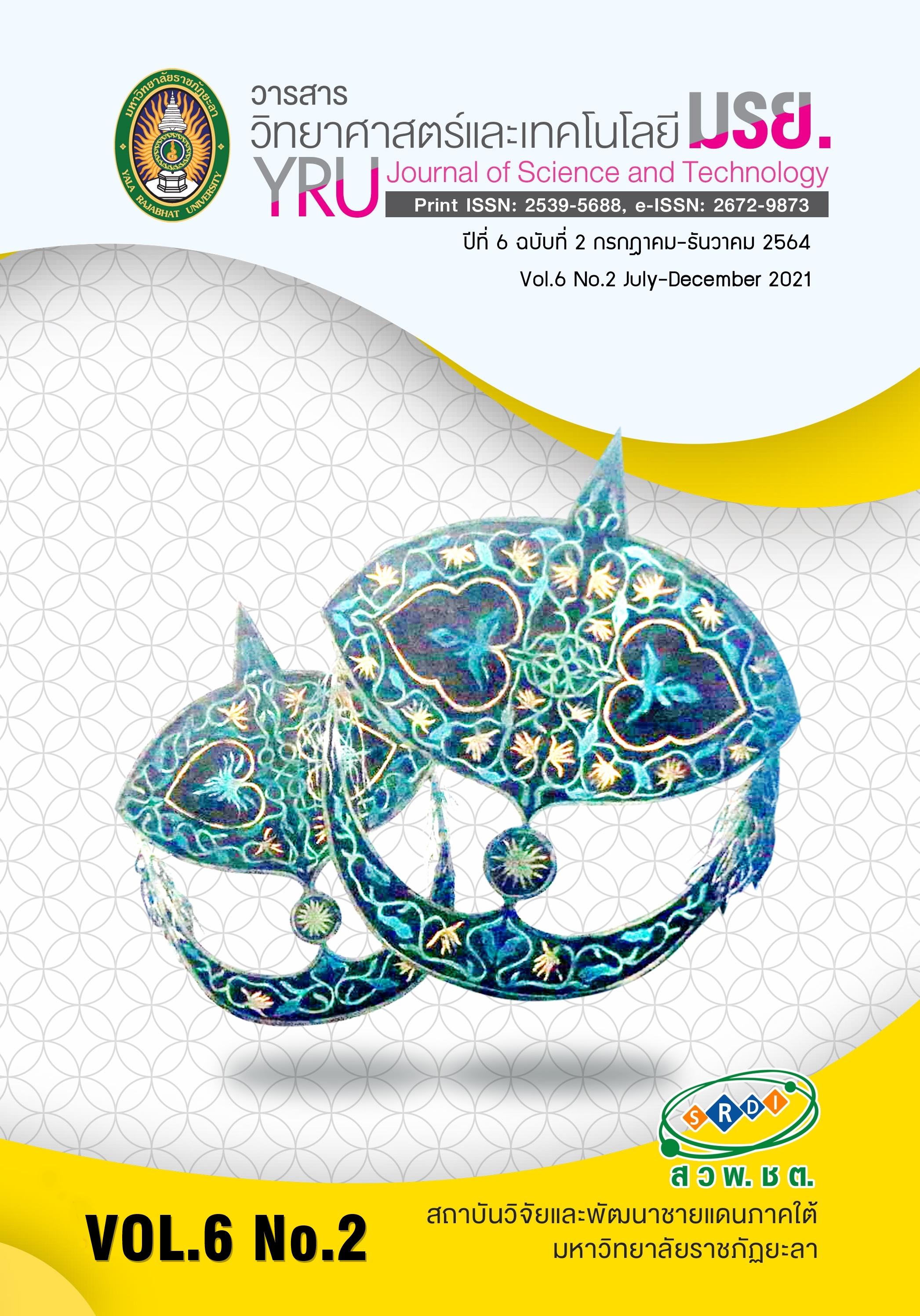ความเข้มข้นที่เหมาะสมขององค์ประกอบน้ำยาพรมศพเพื่อควบคุมการเจริญของเชื้อราจากร่างอาจารย์ใหญ่
Main Article Content
บทคัดย่อ
คณะแพทยศาสตร์ มหาวิทยาลัยนราธิวาสราชนครินทร์ ตั้งอยู่ทางภาคใต้ของประเทศไทยที่มีลักษณะภูมิอากาศแบบร้อนชื้น ส่งผลให้มีการเจริญของเชื้อราบนร่างอาจารย์ใหญ่ที่ใช้สำหรับการเรียนของนักศึกษาแพทย์ แม้ผ่านกระบวนการกำจัดเชื้อราแล้วก็ยังคงพบการปนเปื้อน การศึกษานี้จึงมีวัตถุประสงค์เพื่อระบุชนิดของเชื้อราซึ่งนำไปสู่การปรับองค์ประกอบของน้ำยาพรมศพให้มีประสิทธิภาพเพียงพอต่อการยับยั้งการเจริญของเชื้อรา จากการทดลองสามารถระบุชนิดของเชื้อราที่เกิดขึ้น รวม 7 สกุล ได้แก่ Penicillium sp. Cladosporium sp. Aspergillus sp. Aureobasidium sp. Chrysosporium sp. Sepedonium sp. และ Alternaria sp. โดยพบว่า Cladosporium sp. B2 คือสายพันธุ์ที่พบจำนวนมากที่สุดบนร่างอาจารย์ใหญ่ จากนั้นนำมาทดสอบด้วยสารยับยั้งการเจริญของเชื้อรา ได้แก่ Carbolic acid และ Glycerin เพื่อศึกษาความสามารถในการยับยั้งเชื้อราของสารในแต่ละชนิด ออกแบบการทดลองโดยศึกษาปัจจัยร่วมของสารทั้งสองชนิดโดยวิธี Central Composite Design (CCD) พบว่า Carbolic acid ที่ความเข้มข้น 8% (v/v) และ Glycerin ที่ความเข้มข้น 35% (v/v) มีความสามารถในการยับยั้งการเจริญของเชื้อรา Cladosporium sp. B2 มากที่สุด (39.43%) อย่างไรก็ตาม Carbolic acid ที่ความเข้มข้น 8% ยังคงเป็นระดับที่ทำให้เกิดพิษต่อสุขภาพของผู้ปฏิบัติงานในระยะยาวได้ ดังนั้นสมการแสดงความสัมพันธ์ระหว่าง Carbolic acid และ Glycerin ต่อการยับยั้งการเจริญของเชื้อราซึ่งได้จากการศึกษาทดลองนี้ จึงมีความสำคัญ เพื่อนำไปสู่การคำนวณหาปริมาณความเข้มข้นที่เหมาะสม เพียงพอต่อการยับยั้งการเจริญของเชื้อราและสามารถลดความเป็นพิษจาก Carbolic acid ได้
Article Details
บทความ ข้อมูล เนื้อหา รูปภาพ ฯลฯ ที่ได้รับการเผยแพร่ในวารสารวิทยาศาสตร์และเทคโนโลยี มรย. นี้ ถือเป็นลิขสิทธิ์ของวารสารวิทยาศาสตร์และเทคโนโลยี มรย. หากบุคคลหรือหน่วยงานใดต้องการนำทั้งหมดหรือส่วนหนึ่งส่วนใดไปเผยแพร่ต่อหรือกระทำการใดๆ จะต้องได้รับอนุญาตเป็นลายลักษณ์อักษรจากวารสารวิทยาศาสตร์และเทคโนโลยี มรย. ก่อนเท่านั้น
เอกสารอ้างอิง
Bhuyan, D.J., & Basu, A. (2017). Phenolic compounds: potential health benefits and toxicity, Utilization of bioactive compounds from agricultural and food production waste. U.S.A.: CRC Press.
Brenner, E. (2014). Human body preservation–old and new techniques. Journal of Anatomy,224 (3), 316-344.
El-Katatny, M.H., & Emam, A.S. (2020). Control of postharvest tomato rot by spore suspension and antifungal metabolites of Trichoderma harzianum. Journal of Microbiology, Biotechnology and Food Sciences, 9(5), 1505-1528.
Flannigan, B. (1997). Air sampling for fungi in indoor environments. Journal of Aerosol Science, 28(3),381-392.
Fu, X., Guo, J., Finkelbergs, D., He, J., Zha, L., Guo, Y., & Cai, J. (2019). Fungal succession during mammalian cadaver decomposition and potential forensic implications. Scientific reports, 9(1), 1-9.
Gams, W., Van der Aa, H.A., Van der Plaats-Niterink, A.J., Samson, R.A., & Stalpers, J.A. (1987). CBS course of mycology (3th ed.). Baarn: Centraalbureau voor schimmelcultures.
Giri, P.P., Sinha, R., Sikka, S., & Meur, S. (2016). Acute carbolic acid poisoning: A report of four cases. Indian Journal of Critical Care Medicine, 20(11), 668-670.
Malloch, D. (1981). Moulds, their isolation, cultivation, and identification. Toronto: University of Toronto Press.
Myers, R.H., Montgomery, D.C. & Anderson-Cook, C.M. (2016). Response surface methodology: process and product optimization using designed experiments (4th ed.). New Jersey: John Wiley & Sons.
Reanprayoon, P. & Yoonaiwong, W. (2012). Airborne concentrations of bacteria and fungi in Thailand border market. Aerobiologia, 28(1), 49-60.
Segers, F. J., van Laarhoven, K.A., Huinink, H.P., Adan, O.C., Wösten, H.A., & Dijksterhuis, J. (2016). The indoor fungus Cladosporium halotolerans survives humidity dynamics markedly better than Aspergillus niger and Penicillium rubens despite less growth at lowered steady-state water activity. Applied and environmental microbiology, 82(17), 5089-5098.
Sri-Indrasutdhi, V., Ueapattanakit, J., & Sommatas, A. (2015). Investigation of airborne fungi and their ability to grow on formalin-fixed human cadavers. Mycosphere, 6(06), 729-736.
Sun, J.Z., Liu, X.Z., McKenzie, E.H., Jeewon, R., Liu, J.K.J., Zhang, X.L., Zhao, Q. & Hyde, K.D. (2019). Fungicolous fungi: terminology, diversity, distribution, evolution, and species checklist. Fungal Diversity, 95, 337-430.
Xu, Y., Hall Iii, C. & WolfHall, C. (2008). Fungistatic activity of heat treated flaxseed determined by response surface methodology. Journal of Food Science, 73(6), 250-256.
Zhang, Z., Reponen, T., & Hershey, G. K.K. (2016). Fungal exposure and asthma: IgE and non-IgE-mediated mechanisms. Current Allergy and Asthma Reports, 16(12), 86-98.


